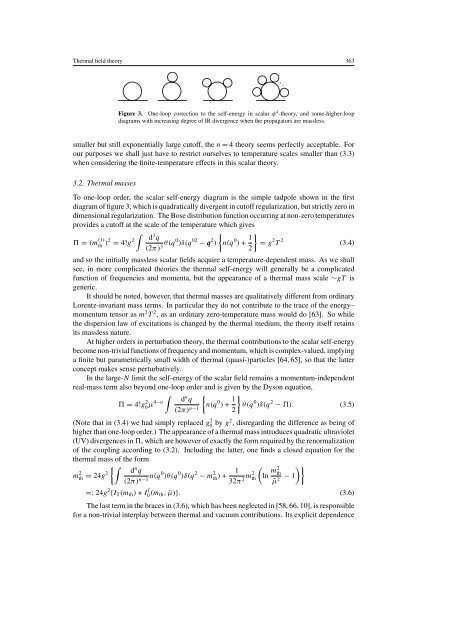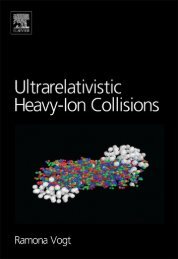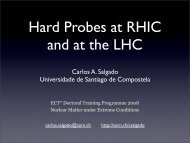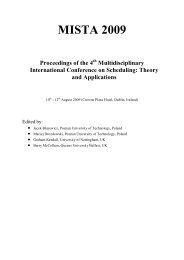Advances in perturbative thermal field theory - Ultra-relativistic ...
Advances in perturbative thermal field theory - Ultra-relativistic ...
Advances in perturbative thermal field theory - Ultra-relativistic ...
Create successful ePaper yourself
Turn your PDF publications into a flip-book with our unique Google optimized e-Paper software.
Thermal <strong>field</strong> <strong>theory</strong> 363<br />
Figure 3. One-loop correction to the self-energy <strong>in</strong> scalar φ 4 -<strong>theory</strong>, and some-higher-loop<br />
diagrams with <strong>in</strong>creas<strong>in</strong>g degree of IR divergence when the propagators are massless.<br />
smaller but still exponentially large cutoff, the n = 4 <strong>theory</strong> seems perfectly acceptable. For<br />
our purposes we shall just have to restrict ourselves to temperature scales smaller than (3.3)<br />
when consider<strong>in</strong>g the f<strong>in</strong>ite-temperature effects <strong>in</strong> this scalar <strong>theory</strong>.<br />
3.2. Thermal masses<br />
To one-loop order, the scalar self-energy diagram is the simple tadpole shown <strong>in</strong> the first<br />
diagram of figure 3, which is quadratically divergent <strong>in</strong> cutoff regularization, but strictly zero <strong>in</strong><br />
dimensional regularization. The Bose distribution function occurr<strong>in</strong>g at non-zero temperatures<br />
provides a cutoff at the scale of the temperature which gives<br />
= (m (1)<br />
th )2 = 4!g 2 ∫<br />
d 3 q<br />
(2π) 3 θ(q0 )δ(q 02 − q 2 )<br />
{<br />
n(q 0 ) + 1 2<br />
}<br />
= g 2 T 2 (3.4)<br />
and so the <strong>in</strong>itially massless scalar <strong>field</strong>s acquire a temperature-dependent mass. As we shall<br />
see, <strong>in</strong> more complicated theories the <strong>thermal</strong> self-energy will generally be a complicated<br />
function of frequencies and momenta, but the appearance of a <strong>thermal</strong> mass scale ∼gT is<br />
generic.<br />
It should be noted, however, that <strong>thermal</strong> masses are qualitatively different from ord<strong>in</strong>ary<br />
Lorentz-<strong>in</strong>variant mass terms. In particular they do not contribute to the trace of the energy–<br />
momentum tensor as m 2 T 2 , as an ord<strong>in</strong>ary zero-temperature mass would do [63]. So while<br />
the dispersion law of excitations is changed by the <strong>thermal</strong> medium, the <strong>theory</strong> itself reta<strong>in</strong>s<br />
its massless nature.<br />
At higher orders <strong>in</strong> perturbation <strong>theory</strong>, the <strong>thermal</strong> contributions to the scalar self-energy<br />
become non-trivial functions of frequency and momentum, which is complex-valued, imply<strong>in</strong>g<br />
a f<strong>in</strong>ite but parametrically small width of <strong>thermal</strong> (quasi-)particles [64, 65], so that the latter<br />
concept makes sense <strong>perturbative</strong>ly.<br />
In the large-N limit the self-energy of the scalar <strong>field</strong> rema<strong>in</strong>s a momentum-<strong>in</strong>dependent<br />
real-mass term also beyond one-loop order and is given by the Dyson equation,<br />
= 4!g 2 0 µ4−n ∫<br />
d n q<br />
(2π) n−1 {n(q 0 ) + 1 2<br />
}<br />
θ(q 0 )δ(q 2 − ). (3.5)<br />
(Note that <strong>in</strong> (3.4) we had simply replaced g0 2 by g2 , disregard<strong>in</strong>g the difference as be<strong>in</strong>g of<br />
higher than one-loop order.) The appearance of a <strong>thermal</strong> mass <strong>in</strong>troduces quadratic ultraviolet<br />
(UV) divergences <strong>in</strong> , which are however of exactly the form required by the renormalization<br />
of the coupl<strong>in</strong>g accord<strong>in</strong>g to (3.2). Includ<strong>in</strong>g the latter, one f<strong>in</strong>ds a closed equation for the<br />
<strong>thermal</strong> mass of the form<br />
{∫<br />
m 2 th = d n ( )}<br />
q<br />
24g2 (2π) n−1 n(q0 )θ(q 0 )δ(q 2 − m 2 th ) + 1<br />
32π 2 m2 th ln m2 th<br />
¯µ − 1 2<br />
=: 24g 2 {I T (m th ) + I f 0 (m th, ¯µ)}. (3.6)<br />
The last term <strong>in</strong> the braces <strong>in</strong> (3.6), which has been neglected <strong>in</strong> [58, 66, 10], is responsible<br />
for a non-trivial <strong>in</strong>terplay between <strong>thermal</strong> and vacuum contributions. Its explicit dependence







